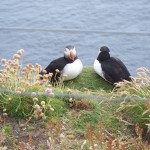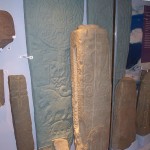Shetland tour:
Lerwick: The main port town in Shetland, where the ferry terminal is situated.
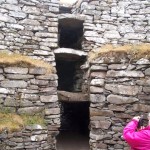 Broch of Clickimin: On the outskirts of Lerwick, sited on a promontory on the shore of Clickimin Loch. A round tower is in the centre of the site. The walls stand to a significant height, showing their hollow construction. There is a thick wall, probably defensive, on the landward side. Around the tower are the remains of other buildings. The site is thought to have been occupied for over a thousand years, and the structures date from different periods.
Broch of Clickimin: On the outskirts of Lerwick, sited on a promontory on the shore of Clickimin Loch. A round tower is in the centre of the site. The walls stand to a significant height, showing their hollow construction. There is a thick wall, probably defensive, on the landward side. Around the tower are the remains of other buildings. The site is thought to have been occupied for over a thousand years, and the structures date from different periods.
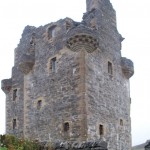 Scalloway Castle: Scalloway Castle was the home of the unpopular Earl Patrick Stewart. The castle was built around 1599, and is an impressive example of a late 1500’s Scottish tower house, with external decoration. The castle is now roofless. It is one of only two castles constructed in Shetland. Next to the castle is the Scalloway museum.
Scalloway Castle: Scalloway Castle was the home of the unpopular Earl Patrick Stewart. The castle was built around 1599, and is an impressive example of a late 1500’s Scottish tower house, with external decoration. The castle is now roofless. It is one of only two castles constructed in Shetland. Next to the castle is the Scalloway museum.
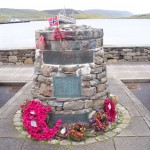 Shetland Bus memorial: The Shetland Bus memorial stands on the waterfront in Scalloway village. It commemorates the boats that carried out clandestine operations between Shetland and Norway during WWII, and their brave crews.
Shetland Bus memorial: The Shetland Bus memorial stands on the waterfront in Scalloway village. It commemorates the boats that carried out clandestine operations between Shetland and Norway during WWII, and their brave crews.
*
*
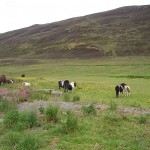 Tingwall Valley: Tingwall Valley runs north-south on Mainland. It has several lochs, and one of the few woods on the island. The name comes from the Ting, the Norse parliament which met on an island, Ting Holm, at the north end of Tingwall loch. The main road passes Tingwall Airport, an airstrip that hosts flights to local destinations.
Tingwall Valley: Tingwall Valley runs north-south on Mainland. It has several lochs, and one of the few woods on the island. The name comes from the Ting, the Norse parliament which met on an island, Ting Holm, at the north end of Tingwall loch. The main road passes Tingwall Airport, an airstrip that hosts flights to local destinations.
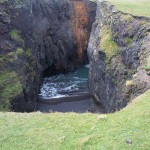 Eshaness cliffs: Eshaness lies at the north-west extremity of the mainland, facing the Atlantic. The cliffs are high, and in places the sea has cut narrow inlets or ‘Geos’ running for hundreds of yards inland in some examples. One has tunneled deeply into the land creating a sea-cave, now partly collapsed at the inner end exposing a long gash in the cliff top with the sea washing far below. (The Holes of Scraada). Nearby is the Loch of Houlland. Here a causeway leads out to a small island, or holm, and a ruined broch stands on a tiny promontory beside it. The broch is much ruined, but one can still make out the structure of the massive walls and some of the inner cells. The loch was once used to feed water down to three Norse watermills, the outlet stream falling into the Holes of Scrada.
Eshaness cliffs: Eshaness lies at the north-west extremity of the mainland, facing the Atlantic. The cliffs are high, and in places the sea has cut narrow inlets or ‘Geos’ running for hundreds of yards inland in some examples. One has tunneled deeply into the land creating a sea-cave, now partly collapsed at the inner end exposing a long gash in the cliff top with the sea washing far below. (The Holes of Scraada). Nearby is the Loch of Houlland. Here a causeway leads out to a small island, or holm, and a ruined broch stands on a tiny promontory beside it. The broch is much ruined, but one can still make out the structure of the massive walls and some of the inner cells. The loch was once used to feed water down to three Norse watermills, the outlet stream falling into the Holes of Scrada.
There is a lighthouse at Eshaness, now automated.
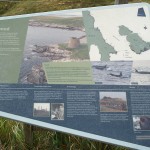 Broch of Mousa: The broch, the best preserved of all the brochs in Scotland, stands on the island of Mousa just off the east coast of the mainland. It can be seen with binoculars from the main road. The broch stands 13m tall and it is possible to climb the winding stair inside it. (I could see the actual broch through binoculars from the mainland).
Broch of Mousa: The broch, the best preserved of all the brochs in Scotland, stands on the island of Mousa just off the east coast of the mainland. It can be seen with binoculars from the main road. The broch stands 13m tall and it is possible to climb the winding stair inside it. (I could see the actual broch through binoculars from the mainland).
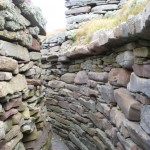 Jarlshof: The remains at Jarlshof represent occupation over about four thousand years. Buildings on the site include the remains of a Bronze Age smithy, an Iron Age broch and roundhouses, a complex of Pictish wheelhouses, a Viking longhouse, and a mediaeval farmhouse. The site, asides from the prominent Old House of Sumburgh, was unknown till the 19th century when an storm uncovered part of the site. The latter, formerly a farmhouse, was converted into a fortified house during the 16th century by the notorious Robert Stewart, First earl of Orkney.
Jarlshof: The remains at Jarlshof represent occupation over about four thousand years. Buildings on the site include the remains of a Bronze Age smithy, an Iron Age broch and roundhouses, a complex of Pictish wheelhouses, a Viking longhouse, and a mediaeval farmhouse. The site, asides from the prominent Old House of Sumburgh, was unknown till the 19th century when an storm uncovered part of the site. The latter, formerly a farmhouse, was converted into a fortified house during the 16th century by the notorious Robert Stewart, First earl of Orkney.
Most of the structures, including the broch and roundhouses, can be entered. The site is near the southern tip of the Shetland mainland.
